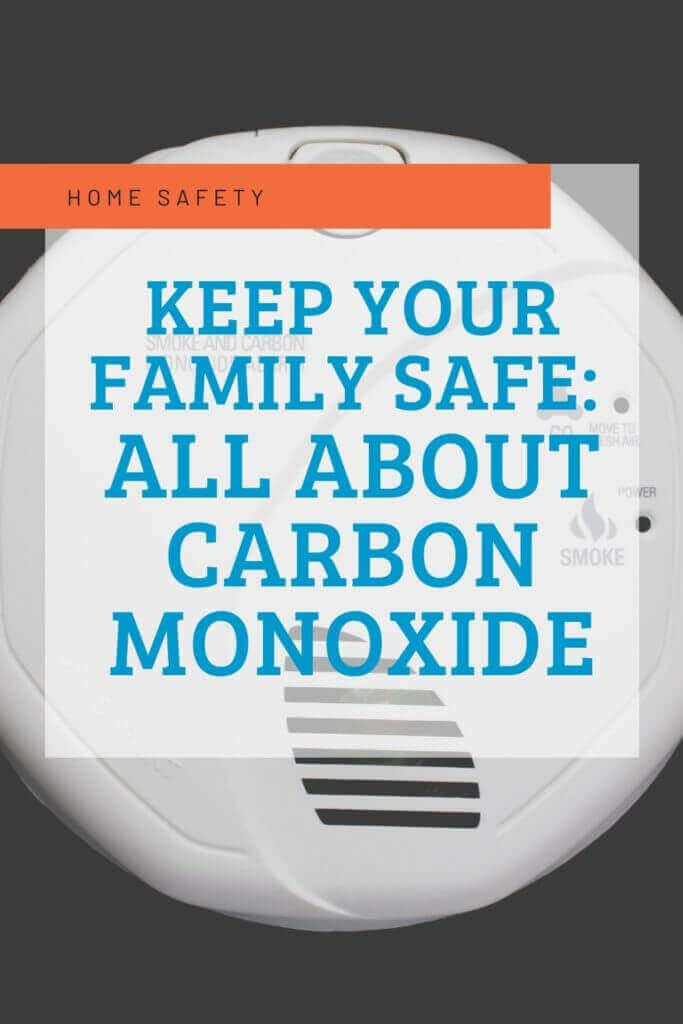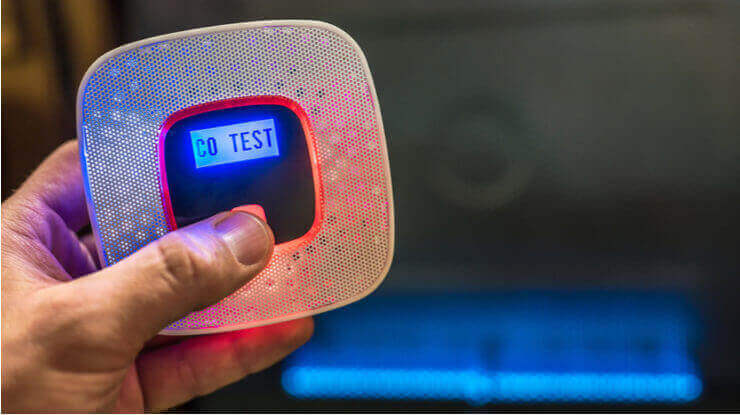Carbon monoxide (CO) is also known as “the silent killer.” Colorless and odorless, carbon monoxide causes the most non-drug accidental poisoning deaths in the US, according to the CDC.
Here’s a primer on carbon monoxide and how to detect and avoid CO issues with the natural gas appliances in your home.
What Causes Carbon Monoxide in Your Home?
Carbon monoxide is produced when fuels such as gas, oil, propane, kerosene, coal and wood do not burn fully.
Improper ventilation of natural gas appliances is the most common cause of carbon monoxide in the home. These appliances include your natural gas furnace in your central HVAC system, a gas water heater, gas stove and gas fireplace.
And the leading single cause of CO poisoning at home is an improperly installed, gas-powered emergency generator.
When maintained, installed and ventilated correctly, your natural gas appliances are safe to use. However, approximately 73% of all carbon monoxide poisonings occur in the home.
Here are the most common in-home sources of carbon monoxide poisonings, according to CDC data from 2009.

What are the Effects of CO Poisoning?
Carbon monoxide interferes with the blood’s ability to carry oxygen through the body.
The most common effect of carbon monoxide poisoning is a tension-type headache. This is a headache that “feels like a tight band around your head” often accompanied by tight neck muscles and a feeling of pressure behind the eyes.
Other symptoms of include dizziness, nausea, confusion, tiredness and shortness of breath.
Prolonged exposure to low levels of CO can also lead to neurological issues such as confusion, impaired memory and difficulty in certain tasks including goal-setting, planning, organization, self-care, and ability to adapt to changing circumstances. (CDC, 2009)
Exposure to concentrated levels of carbon monoxide cause loss of balance, vision and consciousness, and could lead to death.
Why is Carbon Monoxide Called the Silent Killer?
Carbon monoxide is a gas with no taste, color or odor. and odorless gas. Since we can not identify a CO problem in our homes, consumers must properly maintain their natural gas appliances. Carbon monoxide detectors in your home can help identify if you have an issue.
How to Detect Carbon Monoxide Leaks in Gas Appliances
Your gas furnace is the most common cause of CO problems in your home. Estes Air, an Atlanta Georgia plumbing and heating company, lists these as possible visual signs of a carbon monoxide problem in your HVAC furnace:
- Excessive rust on flue pipes or appliance jackets
- Moisture at the flue pipe or vents
- Streaks of soot on the service door of your furnace
- Rust on exterior vent pipes
For your water heater, Atlas Butler, a plumbing and HVAC company in Columbus Ohio, advises to make sure your water heater is properly vented. The vent pipe should reach outside your home, and kept clear of debris, nest and animals.
For your gas fireplace, watch for any sign that the gas is not burning efficiently, such as high levels of soot.
The best way to detect carbon monoxide in your home? Install a carbon monoxide detector. CO is a deadly gas that can not be seen, smelled or tasted. That’s why you need special device to protect your home. Test it regularly, and changed the batteries every 6-12 months.
Where Should I Install a Carbon Monoxide Detector?
A simple rule of thumb is to place a CO detector in the same area where you would place your smoke detectors.
At a minimum, you should have one outside every sleeping area, and one on every level of your home, including the basement. And if you have an attached garage, install a CO detector inside your home, within 10 feet of the garage door.
Place carbon monoxide detectors at knee height, at least 15 feet from any natural gas powered appliances.
According to Family Handyman, CO will not rise all the way up to the ceiling until concentrations are at very high levels. Thus the knee height placement is important, to sense even low levels of CO.
The detecting mechanism in a carbon dioxide alarm is sensitive to humidity, excess airflow and temperature change. You should avoid placing it in direct sunlight, and avoid placing them near appliances that generate heat. Also keep them out of humid areas like bathrooms. And, keep them away from air vents in your home.
Read and follow the manufacturer’s manual to ensure proper installation of your CO detector.
What Do I Do If My Carbon Monoxide Detector Goes Off?
If your alarm goes off, leave the house immediately to seek fresh air. Call 9-1-1 and tell the operator that you have a carbon monoxide leak in your home.
Carbon monoxide detectors sound an alarm when they sense a certain amount of carbon monoxide over time. The alarm industry has agreed to a consistent alarm pattern for CO detectors.
If your carbon monoxide detector senses carbon monoxide, you will hear 4 beeps and a pause. The pattern will repeat.
If your COP detector issues 1 beep every minute, you should replace the batteries. (Replace batteries every 6 months to be safe!)
If your CO detector issues 5 beeps every minute, or twice every 30 seconds, you need to replace your alarm.
Read the instructions on your CO detector to be sure you can identify each of the warning alarms.
CO Detectors vary in price and features. The Google Nest Protect Alarm-Smoke Carbon Monoxide Detector incorporates smart technology to indicate where the CO is originating from. It has a 10-year life.

How Do You Get Rid of Carbon Monoxide in home?
If your carbon monoxide detector indicates there’s CO in your home, you should immediately leave the home and get to fresh air.
When you are safely out of your home, call 9-1-1 and tell them you have a carbon monoxide alarm at your house.
Fire personnel have CO detection equipment. And, EMT training helps them recognize the signs of CO poisoning. Don’t be embarrassed if it’s a false alarm. The old adage, “better safe than sorry,” holds true here.
CO alarms measure a concentration of gas over a time period. Your alarm may stop sounding after you leave the house, as fresh air will have diluted the CO levels. However, even if your alarm stops sounding, you need to find the source of the gas and what triggered the alarm.
You’ll want to work with a building inspector or an HVAC or plumbing contractor to identify the issue.
It’s important that you leave the house when you hear a carbon monoxide alarm. Simply opening a window in your home is not sufficient to rid your home of this poisonous gas. In fact, opening a window and a staying in a closed-in room can further complicate the issue. An open window can create a draft, pulling even more CO under your door.
Why Do Carbon Monoxide Detectors Expire?
You’ll need to replace your CO detector every 5 to 7 years.
The reason? The sensors in your system — whether biomimetic, metal oxide or electrochemical sensor — can become less effective over time. Also, the air filter on the side of your detector can also become clogged with dirt or dust.
In 2009, Underwriters Laboratory (UL) began requiring that all carbon dioxide detectors include an “end of life” alarm, to notify consumers when it needs to be replaced. Check your manufacturers alarm codes so you can identify this signal.
Do not ignore alarms that indicate your CO detector needs to be replaced!
Most alarms have a manufactured date that you can use to estimate when you need to replace it.
TIP: Put a label with the replacement date on your carbon dioxide detector. This will give you a visual reminder to replace your alarm.
Do I Need a Low Level Carbon Monoxide Detector in my Home?
Carbon monoxide alarms are what’s called a “time-weighted alarm.” It measures the build-up and levels of CO over a period of time, to determine the danger level.
The most recent Underwriter Laboratories standard allow for low levels of CO without an alarm. Current standard allow for low levels of CO (30 parts per million) for 30 days before alarming.
According to OSHA, adults can be exposed to 50 parts per million of carbon dioxide for a continuous 8 hour period without exhibiting any symptoms.
However, carbon dioxide exposure at any level can be dangerous for certain more sensitive populations. If you are pregnant or have infants or elderly in your home, you should have a low-level carbon monoxide detector.
Can Electric Heaters Cause Carbon Monoxide Poisoning?
No, electric space heaters do not produce CO. Electric space heaters don’t burn combustible fuel. CO is only produced when burning combustible materials.
Many consumers use electric space heaters to warm areas of their homes, as a supplement to their natural gas furnace/HVAC. Modern space heaters are energy efficient and do not use large amounts of electricity.
Why Should I Have My Natural Gas Furnace Inspected Annually?
Get your natural gas furnace inspected and serviced annually to ensure it’s operating efficiently. That will help you save money on your heating bill. And it can help keep it working correctly, keeping you safe from CO poisoning.
Within your gas furnace, parts can wear out due to the high levels of heat generated. Your HVAC technician will inspect the heat exchanger (the main part of your furnace) to ensure it’s not cracked. He or she will also check your chimney and other ventilation outlets to ensure they are not blocked. And, they’ll test the gases that are coming out of your furnace to ensure there’s no CO present.
Most manufacturers recommend an annual inspection and tune-up.
If you are concerned about saving money on your gas and electric bills, you can also perform a DIY Home Energy Audit. You can check your ventilation, air seals and insulation yourself.
amzn_assoc_placement = “adunit0”; amzn_assoc_search_bar = “true”; amzn_assoc_tracking_id = “elecplans-20”; amzn_assoc_search_bar_position = “bottom”; amzn_assoc_ad_mode = “search”; amzn_assoc_ad_type = “smart”; amzn_assoc_marketplace = “amazon”; amzn_assoc_region = “US”; amzn_assoc_title = “Shop Related Products”; amzn_assoc_default_search_phrase = “low level carbon monoxide detector”; amzn_assoc_default_category = “All”; amzn_assoc_linkid = “389e12ac3a27dc104637f3edba05c176”;Pin this to your Pinterest boards for reference!

